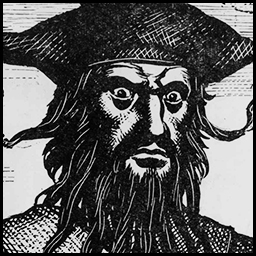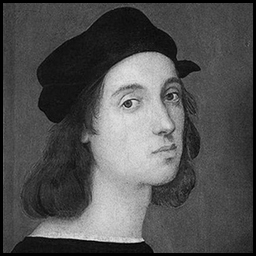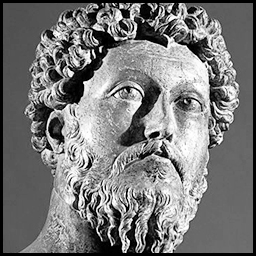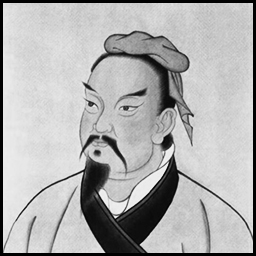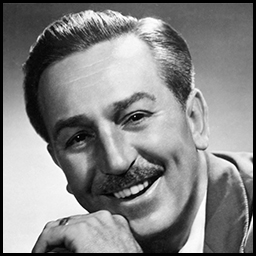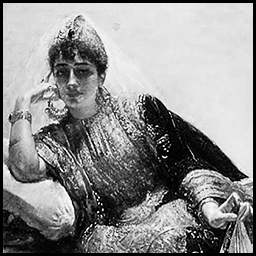a.k.a: Blackbeard
Occupation: Pirate
Born: 1680
Died: 1718
Brief Description:
Edward Teach or Blackbeard’s origins are very mysterious for such a well-known pirate. Pirates habitually used fictitious surnames while engaged in piracy so as not to tarnish the family name so it’s unlikely that Teach was his real name but the commonly accepted theory is that he was a commoner born in Bristol during the 1680s, moved to the Caribbean to become a privateer during Queen Anne’s War and later settled in the Bahamian island of New Providence to become a pirate.
Blackbeard’s pirate life was characterized by his imposing appearance and his willingness to use intimidation tactics to get what he wanted. He was known for his long black beard, which he often tied into multiple braids and tucked under his hat, as well as his propensity for wearing multiple pistols and swords at once. He was also known to light fuses in his beard and hat, creating a smoky, intimidating appearance that struck fear into the hearts of his enemies.
Despite his fearsome reputation, there is evidence to suggest that Blackbeard was not as violent as his legend suggests. He is rumored to have never killed a captive or harmed a crew member who surrendered peacefully. Instead, he often preferred to use intimidation tactics rather than violence to get what he wanted.
Blackbeard’s most famous conquest was the capture of the French slave ship La Concorde in 1717, which he converted into his flagship, the Queen Anne’s Revenge. After capturing La Concorde, Blackbeard made a number of modifications to the ship, transforming it into a heavily armed pirate vessel. He added 40 guns to the ship’s arsenal, as well as a crew of over 300 men. The ship was also outfitted with extra masts and rigging, which allowed it to travel at high speeds and maneuver with ease.
At that time, Blackbeard was at the height of his power, with a fleet of several ships and a reputation as one of the most fearsome pirates on the seas. And under his command, the Queen Anne’s Revenge became one of the most feared ships on the seas and was involved in numerous battles and raids.
In May 1718, Blackbeard carried out a daring blockade of Charleston, South Carolina, which was one of the busiest ports in the American colonies. His goal was to extract a ransom from the city and to capture valuable hostages, including the governor. The blockade began on May 24, when Blackbeard sailed his ships into the harbor and demanded that the city surrender. He then ordered his men to set up a blockade at the mouth of the harbor, effectively cutting off all sea traffic to and from the city. Over the course of the next week, Blackbeard and his crew looted several vessels that attempted to leave the harbor, including a ship that was carrying the governor’s personal effects. They also captured several high-ranking officials, including Samuel Wragg, the Speaker of the Commons House of Assembly, and Thomas Smith, the former governor of South Carolina. Despite the chaos and disruption caused by Blackbeard’s blockade, the city of Charleston refused to pay the ransom that he demanded. In the end, Blackbeard sailed his fleet into the harbor and terrified the locals but left with a plunder worth less than two thousand pounds.
Later in June 1718, the Queen Anne’s Revenge ran aground on a sandbar, cracking her main mast and severely damaging many of her timbers beyond repair. Having lost the Queen Anne’s Revenge, Blackbeard accepted a royal pardon and settled down in Bath. But while he seemed to be living an honest life now, he had actually taken piracy to a new level. His men roamed the Carolina rivers taking ships as they always had done.
In response to the growing threat, the governor of Virginia, Alexander Spotswood, dispatched a naval expedition led by Lieutenant Robert Maynard to capture or kill the notorious pirate. The two forces engaged in a fierce battle off the coast of North Carolina, during which Blackbeard was killed. According to some reports, he sustained as many as five gunshot wounds and twenty sword cuts before finally succumbing to his injuries.
Teach’s corpse was thrown into the inlet and his head was suspended from the bowsprit of Maynard’s sloop. On their return to Virginia, Teach’s head was placed on a pole at the entrance to the Chesapeake Bay as a warning to other pirates and a greeting to other ships, and it stood there for several years.
Why he’s on the list:
As you’ve probably noticed already, skill and charisma are two recurring points in my portraits and with Blackbeard, it’s no different. It is believed that Teach was a skilled sailor and tactician, which allowed him to quickly rise through the ranks and become a captain in his own right and his imposing appearance helped him get the intimidation and respect he wanted.
But if Blackbeard is on this list, it’s to represent the pirates from the golden age of piracy as a whole. Not only was he an iconic pirate but he was also friends with many of the other famous pirates of that time. And many of his actions were often carried out for the benefit of piracy in general rather than his own personal gain.
So why do I like pirates?
Simply because they were free, free of a captive world filled with rules.
Pirates also had quite democratic systems in place and members of the crew had equal rights. They were also generally anti-racism and anti-slavery. And they were seen by many as the good guys, despite what the history books make them look like. And that is one of the main reasons why governments and influential figures were constantly afraid of them.
And then of course there’s the romance of the sea, the sword fights and the thrill of great adventures!
